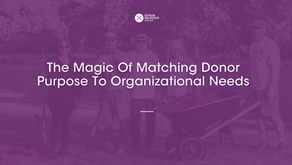Marginal Gains for Strategic Donor Relations: Small Steps for Big Impact
- Lynne Wester

- Aug 1, 2023
- 4 min read

Now that you’ve had a chance to dabble in some of the strategies shared in our previous series on behavior economics (catch up here → Part 1 and Part 2), you’re ready to step up your game. Enter the Principle of Marginal Gains.
If the first series provided the foundation for behavior economics, then think of the Principle of Marginal Gains as unlocking the how of achieving remarkable results.
What Are Marginal Gains?
At its core, the Principle of Marginal Gains is the idea that making small, incremental improvements of just 1% in various areas can lead to a significant overall improvement in performance.
In short, multiple tiny improvements compound, resulting in noteworthy positive outcomes.
Such an impact is illustrated in James Clear’s #1 New York Times bestselling book Atomic Habits:
"The difference a tiny improvement can make over time is astounding. Here’s how the math works out: if you can get 1 percent better each day for one year, you’ll end up thirty-seven times better by the time you’re done. Conversely, if you get 1 percent worse each day for one year, you’ll decline nearly down to zero."
Did you see that? ☝️ 37% better?! Raise your hand if you would like to experience 37% improvement in your fundraising acquisition and retention efforts. 🙋🏻♀️
Sound Familiar?
Before we dive deeper, let's explore how the Principle of Marginal Gains has demonstrated its power in real-life scenarios.
In the film Moneyball, we learn the story of the Oakland Athletics baseball team and their general manager, Billy Beane, who used statistical analysis to identify undervalued players and build a winning team on a limited budget. Beane's approach was based on the idea that minor improvements to the lineup and player performance could add up to a significant improvement in the team's overall performance. When Dave Brailsford was hired as the new performance director for the British Cycling team in 2003, the British cycling team had not won a single gold medal since 1908. That's nearly 100 years of being just...meh. 😕 In fact, they were so bad that a top bike manufacturer in Europe actually refused to sell bikes to the team. The brand was scared it would ruin their reputation if other pros saw the Brits using their gear! Y'all – that's bad. 😬 However, Brailsford monumentally changed the team's trajectory, and from 2007 to 2017, the British team won:
178 world championships
66 Olympic or Paralympic gold medals
5 Tour de France victories
How did he do it? You guessed it! The Principle of Marginal Gains, or what some call the 1% Difference Theory. By emphasizing small details and continuous improvement, we can all achieve long-term success like Billy Beane and Dave Brailsford.
The 1% Difference and You
As FY24 gets underway, we encourage you to do a strategic audit. Throw all of your current responsibilities and wish-list items on a single spreadsheet. Then identify where each of the tasks fall on the below Effort/Impact Matrix (you can even do this activity with a stack of sticky notes and a blank wall!):
The Major Projects and Quick Wins tend to get most of the attention from leadership – understandably so. Who doesn’t want to see a big impact? And since Quick Wins require the least amount of effort, just do them. It makes sense. Always.
Did you also notice that bottom left quadrant – Marginal Gains? At first glance, such tasks may appear to be inconsequential. However, in volume, these small, easy tweaks can amplify what we’re already doing.
(Also, not sure who needs to hear this, but it’s time to let go of any Thankless Tasks. These high-effort and low-impact responsibilities are time-wasters.)
Putting Behavior Economics to Work
To begin implementation, refer to the cheat sheet from our previous posts (Part 1 and Part 2) as inspiration, and then start small with easy-to-implement changes for a big impact. Some examples:
Use QR codes on printed communications to direct readers to a specific webpage
Precede any solicitation series with a gratitude email or postcard
Eliminate unnecessary fields on your giving portal
Make text font, color, and size more readable on communications
Schedule social media posts at optimal times for your audience
Use the word ‘you’ more than ‘I,’ ‘we,’ or your organization’s name
Use an AI tool like Copy.ai, Grammarly, or ChatGPT to edit and make your communications more concise
Include a call to action on every webpage and communication piece
Take ‘thank you’ out of your solicitations and asks out of your stewardship pieces (learn more about the flawed practice of “thasking”)
Make your ‘Give Now’ button visible on every page of your website
Enhance your giving confirmation page with images, donor-centered language, and impact stories
Create a default gift array on your giving portal
Use a PS at the end of your communications to reiterate a call to action
Now remember, class:
Marginal ≠ Insignificant.
Ultimately, by focusing on marginal gains in the area of behavior economics, organizations can achieve long-term success in fundraising.
Start tracking your progress and adjust strategies as necessary.
By making small improvements in areas like donor experience, communications, and efficiency, we can increase the world's supply of generosity.
What are some simple, yet powerful changes you can begin implementing today?






